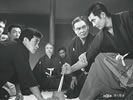Eye For Film >> Movies >> The Flowers And The Angry Waves (1964) Film Review
Japan's current 'wild child' Takashi Miike (Audition, Dead Or Alive, Ichi the Killer) is often celebrated both for the extraordinary rate at which he makes films (three to four per year), and his exuberant manner of resisting the conventional genre boundaries within which he nominally works. Yet Miike is not entirely without precedent. For in his day Seijun Suzuki could lay claim to being just as prolific, and just as much of a rule-breaker.
Suzuki is still active today, his latest production being Princess Raccoon (2005), but it was between the years 1956 and 1968, when he was under contract with the Nikkatsu studio, that he made his name - directing an extraordinary 40 B-grade films in just 12 years, and edging further and further from the genre restrictions imposed upon him until finally, after his uncategorisable tour-de-force Branded To Kill, the studio promptly fired him.

Though The Flowers And The Angry Waves was made long before Suzuki's forced departure from Nikkatsu, it is possible to discern the director's rebellious trajectory encoded in the character of its hero Kikuji (Akira Kobayashi), banned from the yakuza syndicate which he once served, and constantly in trouble with his new bosses for getting "out of bounds".
In the film's elliptical opening, Kikuji violently abducts his beloved Oshige (Chieko Matsubara) while she is on her way to marry his yakuza boss. Cut to a year later and the lovers are laying low in Tokyo. Kikuji has become a contracted labourer for the Murata clan, while Oshige works as a waitress in an inn in Asakusa - and only the kindly innkeeper Ihei (Kaku Takushina) knows that they are married. Kikuji becomes embroiled in a dangerous conflict between the Murata clan and the rival Tamai gang over a valuable building contract; the tattooed geisha Manryu (Naoko Kubo) has her eyes on Kikuji even as the police detective Tanioka (Isao Tamagawa) is in amorous pursuit of Oshige; and all the while the scar-faced hitman Yoshimura (Tamio Kawaji), hired by both Kikuji's former boss and the Tamai, is circling for the kill. The couple's simple dream of setting up a home and family together seems to grow ever further from fulfilment.
"Let's forget about the past," Ihei tells Tanioka. It is hardly the line you would expect to hear in a period piece, but then The Flowers And The Angry Waves is set at the height of the Meiji restoration, early in the 20th century, when a previously isolationist Japan was opening itself up to foreign influences and new ideas. You can see it in Oshige's much-topicalised modern hairdo, you can see it in Manryu's exotic taste for gin (" a gift from a Westerner"), you can see it in Yoshimura's hat-and-cape outfit - but most of all you can see it in the number of characters who are trying, in one way or another, to distance themselves from their personal histories.
Ihei is a former thug gone straight, Manryu is seeking a better life far from Manchuria, Tanioka is a "demon detective" who just might, as Ihei puts it, "turn into a saint" - and Kikuji is a one-time yakuza driven by love to rebel against his own strict (if criminal) code, who is now "an honest, straight guy" and, of all things, a builder, helping to construct a new power works that, along with his wife's pregnancy, symbolises the nation's future.
Of course nothing is so simple, and Suzuki's film, made during another period of crucial change for Japan (the post-war, post-occupation years), uses its conventional materials (adapted from the pulp novel by Aoyama Koji) to dramatise the difficulties involved in forgetting one's past or escaping one's violent roots entirely. For all his earnest attempts to keep his profile low and his sword sheathed as he heads towards a better future, Kikuji will soon become a killer-on-the-run once again, alone and exiled to Manchuria - the very hell-hole that Manryu had earlier sought to leave behind forever ("life there was so fragile").
Suzuki's style of storytelling is, to put it mildly, oblique, making viewers work hard to see how the multiple strands of the film's narrative fit together - and some will be left both disappointed by the bland characterisation, and confounded as to what purpose many of the film's scenes serve; but on the way, there is certainly enough action - and tension - to keep anyone engaged, while the filmmaker's handling of both period detail and cinematic spectacle is beyond reproach.
Cinematographer Kazue Nagatsuka and production designer Takeo Kimura (who also co-wrote the screenplay) maximise the potential of the Asakusa setting for claustrophobic effect, allowing the camera to weave fluidly from inn to alley to inn again as police and assassin alike squeeze the hapless lovers' relationship from all sides. The final sequence, amidst a maze of shadowy snow-piles near the Niigata docks, is pure film noir. And while in the end it is unclear whether Kikuji or indeed the film itself has got very far, it has nonetheless been a gripping rickshaw ride through some very busy Tokyo mean streets.
Reviewed on: 29 Mar 2007



















